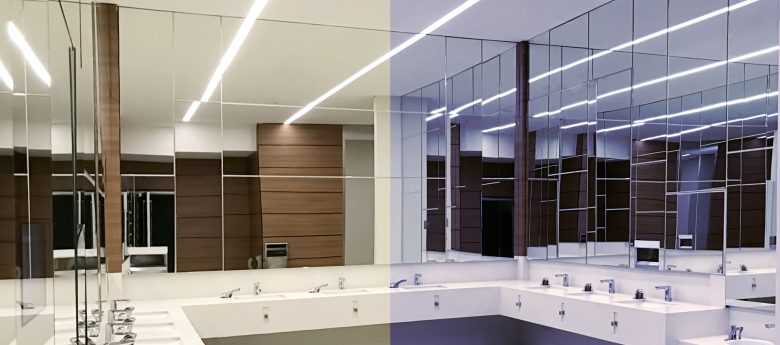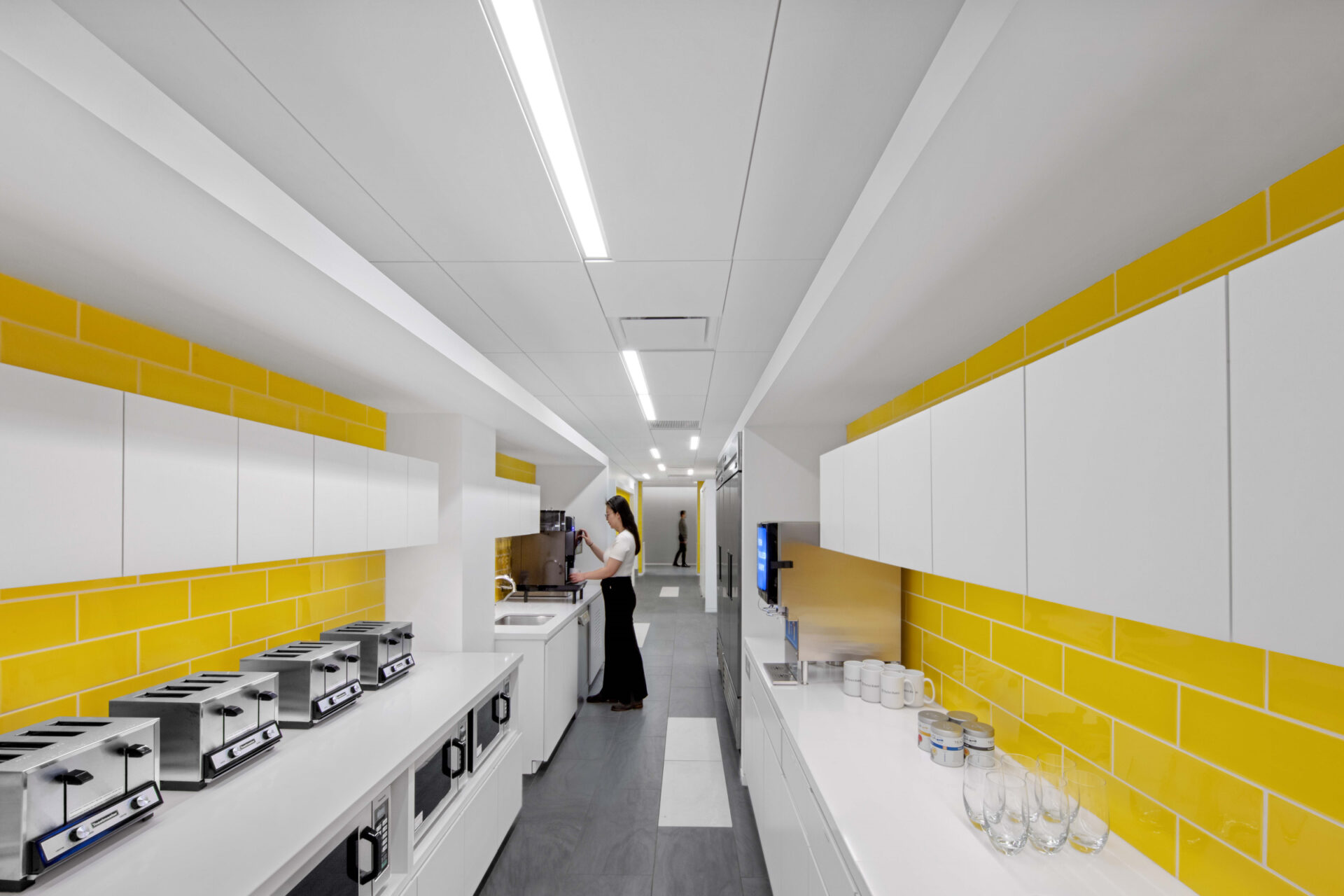Antimicrobial LED Lighting Illuminates Safety

What if there was an effective way for companies to reopen their offices now, not later, and continuously protect their most valuable resources – their staff?
Something new and adaptive, a sterilizing method that goes well beyond extra scrubbing from the nightly cleanup crew?
Today, corporate leadership and boardrooms are in dire search of the answers to that very question as their employees’ comfort level and their company’s fluctuating productivity hang in the balance.
Per a recent Eagle Hill poll, nearly half of workers want their employers to continue delaying their office reopening plans. Equally, most want their employers to stay vigilant in adhering to the strictest of health recommendations – continuous disinfecting efforts included.
For decisionmakers at all levels – from building owners to facility managers and their building teams – these findings suggest workplaces must offer an extra layer of protection against viruses, bacteria and other invisible, infectious diseases.
Not just at the end of the day or overnight, but all day, every day, even during work hours.
Most cleaning solutions, including traditional UV lighting, cannot offer such reassurance when employees are present.
But 405-nanometer, antimicrobial lighting can.
Lighting’s New Office Role
Thanks to recent advancements in LEDs, there’s an innovative approach to mitigating facility contamination.
Antimicrobial LED lighting has quickly become an attractive and valuable asset for offices and facilities wanting to provide a cleaner, healthier inhospitable space for bacteria and viruses, including SARS-CoV-2, which causes COVID-19, according to recent third-party analysis.
The next generation of germicide illumination supplements cleaning crew efforts by reducing the bioburden – the number of microorganisms living on a surface – in all those high-touch, high-volume spaces. Think kitchens, bathrooms, conference rooms and waiting areas. Each setting, research shows, was a breeding ground for microbes long before the pandemic toppled the daily hustle and bustle of commercial spaces.
Antimicrobial lighting also checks off frequently overlooked items such as doorknobs and various desktop items – phones, keyboards, a computer mouse, for instance – that your office cleaning crews are instructed not to touch.
But traditional UV lighting shares many of these powerful, well-documented disinfectant capabilities. So, what makes non-UV antimicrobial lighting so much different?
Why UV Lighting Can Cause Business Disruptions
Perhaps the most significant difference between traditional UV lighting and non-UV antimicrobial lighting is their restrictions.
One (UV light) has many. The other (antimicrobial lighting) has none.
UV lighting is intrinsically dangerous. It works as a harsh disinfectant, piercing a microbe’s nucleus and obliterating nucleic acids while disrupting DNA structures. Prolonged exposure at high-level intensities harms the cellular structure in living things – humans included. Potential eye problems include cataracts, issues with the cornea and temporary or permanent loss of vision. UV lighting can also make it harder for the skin to heal, experts say. It can even cause cancer.
In short, UV lighting is not suitable for extended periods of use when humans are present in a space – like during working hours, which, in some facilities, is around the clock.
This undeniable factor explains why, for all the raving headlines UV lighting has generated over the last year, just as many have warned about its strict limitations and safety issues. Reports continue to alert workplaces about the potential eye damage UV lighting can easily create. Also, announcements about advanced, mobile robots shining UV disinfectant lighting always come with one glaring caveat: A built-in protection feature shuts off the robots’ cleaning capabilities when movement is detected – which, in most workplaces, is all the time.
These cautionary tales emphasize how it’s exceedingly challenging to vow endless disinfecting with UV lighting without disrupting business.
How Antimicrobial Lighting Continuously Disinfects Without Business Disruptions
Alternatively, non-UV antimicrobial lighting meets the international standards for continuous and unrestricted use with people present. That means no business disruptions, no interrupted cleaning services – no worries.
But why?

The illumination uses a wavelength cluster between 400 and 420 nanometers, which has no ill effects of traditional UV lighting. More nanometers traditionally equal more wavelengths on the visible light spectrum, and the shorter the wavelengths below 380 nanometers, the greater the danger to living things.
Also, antimicrobial lighting kills microorganisms differently than UV light does. While UV light penetrates and damages DNA, leaving cells unable to perform vital functions and ultimately cell death, antimicrobial LED does not impact DNA.
Here’s how UV-free antimicrobial LEDs do the trick: The lighting photo activates porphyrin molecules in microbial cells. When activated, they produce excessive Reactive Oxygen Species like singlet oxygen, hydrogen peroxide and hydroxyl groups. Once an excess of Reactive Oxygen Species builds up inside the cells, they become toxic, causing the destruction of cellular structures and ultimately leading to cell death.
Unlike microbial cells, the types of porphyrin molecules found in humans and other animals are contained in our gut and cannot be photoactivated by illumination in the 400-to-420 nanometer range.
Similarly, antimicrobial lighting does not trigger the degradation of materials as UV does. UV rays can break down the chemical bonds found in plastics and cause fabric and other objects to fade in color and structure. Additional benefits include decreases in maintenance – regular bulb replacement and constant oversight become a thing of the past – and crisp, comfortable white ambient lighting that simultaneously disinfects. Select systems also have two or more cleaning methods: one for when staff is present, and the others, which provide deeper-cleaning capabilities, for when they’re not.
With antimicrobial lighting, its varying cleaning modes require just two simple steps: First, set the system up using a preset, timer or sensor. Then, forget it. It’s good to go on its own.
So is your facility for reopening.
Studies Show Antimicrobial Lighting Always Beats the Contamination Challenge
Antimicrobial lighting has been tested in commercial applications nationwide, with its effectiveness constantly exceeding the 90% mark. In many instances, its efficacy has eclipsed the 99% threshold, depending on several factors, including the light’s intensity, the amount of light reaching the surfaces, how the lighting is angled, the length of exposure time and how far away the lighting is from the surface.
For instance, a large corporate office witnessed a 92.4% bioburden reduction on five of its most commonly used surfaces in a breakroom – the toaster, refrigerator, sink, water cooler and trash can – after an antimicrobial clean lighting system was installed.
A classroom at the Taconic Hills Central School District in Craryville, N.Y., experienced a 99.6% reduction in surface bacteria. Likewise, a pre-kindergarten bathroom inside a magnet school in New England saw a similar decrease in bioburden – 99.5%.
Non-UV, antimicrobial lighting is equally effective inside food production facilities. HP Hood, a dairy company based in Massachusetts, experienced a dramatic reduction of various microbial species – up to 99% in some instances – under an experimental antimicrobial lighting system, proof that this type of lighting can play a leading role in reducing pathogens and spoilage in food and dairy processing.
Newly released research also underscores antimicrobial light’s knockout punch on non-enveloped viruses, which are the hardest class of viruses to kill. Examples of these types of viruses include the common cold, dysentery and polio.
Each of these case studies share two additional characteristics – minimal business disruptions and no need to vacate the well-lit space.
Corporate leadership has long required good-quality lighting to boost employee production, health and morale. With the integration of an antimicrobial system, your facility’s overhead illumination could become the gateway to something more: A soothing illumination that welcomes back staff with the company’s commitment to a healthier, cleaner work environment under the right light.
Bill Plageman is the Vice President of Marketing and Product Development at Amerlux, an award-winning design-and-manufacture lighting company that is part of the Delta Electronics family of companies.
